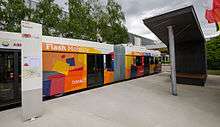TOSA Flash Mobility, Clean City, Smart Bus

The TOSA concept and test bus is a full electric large capacity urban bus system developed in Geneva by the ABB Sécheron Ltd, a company of ABB Group.
Aim of the concept and project
The aim is to provide a zero local emission mass public transportation bus system with high passenger capacity and no overhead line.
The concept supports same operating timetable and frequency as line operated with diesel buses, trolleybuses and operating conditions of Bus Rapid Transit systems. The following aspects have been considered to comply with a sustainable mobility approach:
- Minimise use of raw material throughout the life cycle: lithium-titanate battery technology has been selected accordingly.
- Energy efficiency: High passenger capacity, low vehicle weight (small battery), conductive energy transfer and grid connection with peak shaving.
- Safety and health: Low emission of radiation Non-ionizing radiation during energy transfer at bus stops (conductive connection) and battery technology; zero local emission of particles; low noise; small visual impact.
Origin of name
TOSA stands for Trolleybus Optimisation du Système d'Alimentation (French). Originally, TOSA name stands for Transports Publics Genevois, Office de la Promotion Industrielle, Services Industriels de Genève and ABB Group, the four partners of the demonstrator project TOSA2013[1]
The technical concept
The energy is collected along the route at some dedicated bus stops (every 3rd or 4th bus stops) while people are disembarking and embarking. Thus, there is no impact on the timetable. The automatic electric connection is made from the top within 1 second while the bus is stopped at the bus stop. Than charging is made at high power (400 kW on the demonstrator) during the 15 seconds the door remains open. At the terminal, the battery is topped up within 3–4 minutes.
The infrastructure
According to the line profile (total length and altitude) and service (frequency), the Flash Feeding Station (FFS) are distributed along the line at some (each 3rd or 4th bus stops - roughly 1.5–2 km) intermediate bus stops. At each end of the line, the recharge is performed by the Terminal Feeding Station (TFS).
- FFS: The Flash Feeding sub-Stations are provided with energy storage to shave the peak of power on the grid required to charge the bus at the intermediate bus stops. As power is limited by the energy storage, the sub-station is connection to the low voltage grid.
- TFS: The Terminal Feeding Sub-Stations is used to charge the bus at the terminal.
- DFS: The Depot Feeding Sub-Stations are used to compensate the energy required by the bus from Depot to the line of service
Demonstrator (Proof-of-Concept)

The demonstrator (one articulated bus, one Flash charging station and one terminal station) is in service since May 26, 2013 between Geneva Airport and PALEXPO. It includes:
- one articulated bus of 18.7meters-long and homologation for 133 passengers. The bus manufacturer is the company HESS
- one TFS of 200 kW at the Airport of Geneva
- one FFS of 400 kW at PALEXPO
- one DFS of 50 kW at the depot Bachet-de-Pesay
Partners
Other partners
- Bus manufacturer: HESS
- Architecture design: hepia
- Engineering Software: epfl, HE-Arc
- Financing: Canton of Geneva, Swiss Federal Office of Energy SFOE, Federal roads office FEDRO
- Land: PALEXPO
External links
- Photographs of TOSA during UITP 2013
- TOSA2013 Project in Geneva
- ABB TOSA Flash Mobility, Clean City, Smart Bus[2]
- Video - Flash charging an electric bus in 15 seconds
- Video - OFEN Des bus électriques rechargeables en 15 secondes (French)
- Bus Technical Data (French)
- D’ici trois ans, les bus TOSA rouleront sur la ligne 23 (French)
References
- ↑ http://www.enerzine.com/1036/15865/mise-en-service-dun-bus-electrique-qui-se-recharge-en-15-secondes.html
- ↑ TOSA2013 The project aims to introduce a new system of mass transport with electric “flash” recharging of the buses at selected stops (overhead conductive charging)